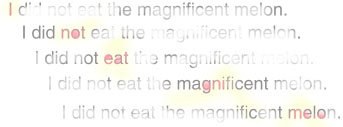

 |
Greg Kochanski |  |
This project will test a common assumption of linguistics, that speech is essentially represented "digitally" in the mind. Phonologists teach that the speech articulators are controlled by sequences of discrete instructions ("phonological features"). So, the tongue root might be ordered forward or back, but intermediate positions do not have an intermediate meaning. This assumption is based on words: sounds in between "cat" and "hat" are not English, and don't convey the image of furry headgear.
We will use Magnetic Resonance Imaging (MRI) to take movies of the tongue and velum, then measure tongue and velum positions and compare the measurements with mathematical models of muscle motion for the words that the subjects are speaking. If the models match the data, the common linguistic assumption can be used with more confidence. If not, we will measure the discrepancy and search for its source. It could mean that the accepted set of articulatory instructions is incorrect, that the instructions are not binary and discrete, or that information beyond the phonological features (e.g. the "tone of voice") is needed. It could also mean that the mathematical models are inappropriate for the tongue and velum, even though they work well for the muscles that drive eyes, arms, and fingers.
Our MRI measurements will focus on the back and root of the tongue and the velum, which are inacessible to most other experimental techniques. We will contrast the case of the tongue root, where the linguistic commands are uncertain, with the motion of the velum, about which there is good data from prior work.
This project also contains two preliminary experiments. One involves careful acoustic analysis of speech, rather than MRI images, and will help us find a good set of sentences for the subject to say that contain suitable articulatory commands. It will also provide a better understanding of the phenomenon of coarticulation (how changes in one sound affect others, sometimes even a few syllables away).
The other preliminary experiment will compare two different ways of taking MRI movies of speech: a real-time technique and a "stroboscopic" method. We will compare these techniques to determine which is better for what purposes. We will learn which technique is best to use for speech research. This practical knowledge may eventually have applications in the diagnosis or treatment of people with speech disorders.
| [ Papers | kochanski.org | Phonetics Lab | Oxford ] | Last Modified Tue May 20 07:31:35 2008 | Greg Kochanski: [ Home ] |